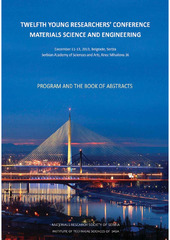Приказ основних података о документу
Microbial polysaccharides as a prospective base for new materials
| dc.creator | Kekez, Branka | |
| dc.creator | Lješević, Marija | |
| dc.creator | Đurić, Aleksandra | |
| dc.creator | Stefanović Kojić, Jovana | |
| dc.creator | Jakovljević, Dragica | |
| dc.creator | Gojgić-Cvijović, Gordana | |
| dc.creator | Beškoski, Vladimir | |
| dc.creator | Vrvić, Miroslav | |
| dc.date.accessioned | 2022-06-18T22:00:23Z | |
| dc.date.available | 2022-06-18T22:00:23Z | |
| dc.date.issued | 2013 | |
| dc.identifier.isbn | 978-86-80321-28-8 | |
| dc.identifier.uri | https://cer.ihtm.bg.ac.rs/handle/123456789/5122 | |
| dc.description.abstract | icrobial polysaccharides (MPS) have high structural variety which leads to a wide diversity of their applications. Main characteristics of these polymers produced by microorganisms are nontoxicity, biocompatibility and biodegradability, which is a significant advantage compared to synthetic polymers. Many of the MPS show a number of attractive properties. Among the most studied MPS is the beta-glucan from S. cerevisiae, due to its antitumor/antiviral activity and possessing a bifidogenic effect. Pullulan from A. pullulans has excellent properties as the result of its unique structure. Levan from B. licheniformis strain has potential for many applications, including synthesis of nanoparticles. | sr |
| dc.language.iso | en | sr |
| dc.publisher | Belgrade : Institute of Technical Sciences of SASA | sr |
| dc.rights | openAccess | sr |
| dc.rights.uri | https://creativecommons.org/licenses/by-nc-nd/4.0/ | |
| dc.source | 12th Young Research Conference – Materials Science and Engineering, Program and book of abstracts, December 11-13, 2013, Belgrade, Serbia | sr |
| dc.subject | Microbial polysaccharides | sr |
| dc.subject | levan | sr |
| dc.title | Microbial polysaccharides as a prospective base for new materials | sr |
| dc.type | conferenceObject | sr |
| dc.rights.license | BY-NC-ND | sr |
| dc.citation.spage | 8 | |
| dc.identifier.rcub | https://hdl.handle.net/21.15107/rcub_cer_5122 | |
| dc.identifier.fulltext | http://cer.ihtm.bg.ac.rs/bitstream/id/21719/bitstream_21719.pdf | |
| dc.type.version | publishedVersion | sr |


